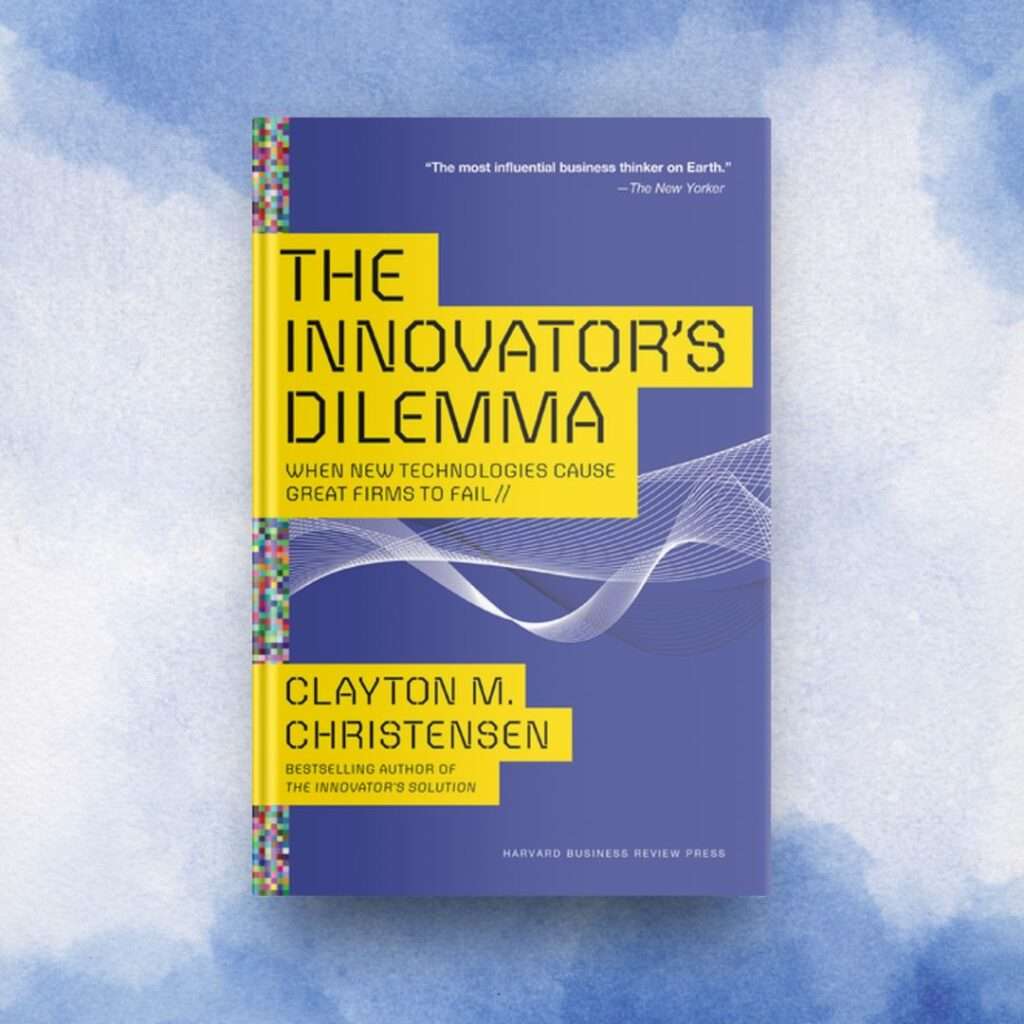Table of Contents
- Introduction
- Unpacking The Innovator’s Dilemma Book
- Why Embrace Disruptive Innovation?
- The Challenges of Embracing Disruptive Innovation
- Strategies for Overcoming The Innovator’s Dilemma
- Case Studies of Successful Disruption
- Conclusion
Introduction
The Innovator’s Dilemma, a book by Clayton Christensen, is considered one of the seminal works on disruptive innovation.
Published in 1997, the book examines how disruptive technologies emerge and upend established companies. Christensen’s key insight is that well-managed companies often fail to embrace disruptive innovations because they are focused on serving their existing customers and investors.

Although the book has been in the market for a long time, I never knew its existence until I enrolled in the Disruptive Strategy course at the Harvard Business School in 2020, which lasted six weeks.
Disruptive innovation is the introduction of new products, services, or business models that significantly alter and transform markets. Disruptive innovations often start out targeting niche segments that established industry leaders ignore. Over time, as the disruptive technology improves, it gains a broader market appeal and can challenge and displace established competitors.
Disruptive innovation is vital in today’s fast-paced business environment as it allows companies to stay ahead of changing customer needs and preferences. Industries that fail to embrace disruptive change often lose relevance and get left behind. Therefore, learning to capitalize on disruptive innovation is key for continued growth and competitiveness.
The Innovator’s Dilemma provides a framework for understanding disruptive innovation and offers strategies for how established firms can adapt and harness disruption rather than being overtaken by it. The concepts outlined in the book remain highly relevant today as businesses across all industries grapple with digital transformation and emerging technologies.
Unpacking The Innovator’s Dilemma Book
The Innovator’s Dilemma introduced several influential concepts that have shaped how businesses think about innovation and growth.
The book’s core premise is that well-managed, successful companies can fail when confronted with disruptive innovations that don’t initially meet the needs of their existing customers.
Christensen argues that disruptive innovations emerge in new markets with different product attributes valued by new customers. As these disruptive innovations improve over time, they eventually displace established companies unwilling or unable to adapt.
Key Themes and Ideas
Some of the key themes and ideas from The Innovator’s Dilemma include:
- The distinctions between sustaining and disruptive innovations.
- How disruptive innovations transform markets by creating new value networks.
- Successful companies fail because they listen too closely to customers and invest in sustaining innovations rather than disruptive ones.
- Disruptive innovations are cheaper, simpler, and more convenient and appeal to new or less demanding customers.
- “The Law of Disruption” – new entrants often displace established companies with disruptive innovations.
Real-world Applications
To illustrate his theories, Christensen used case studies of the disk drive industry and earth excavators, steel mills, and department stores. However, the concepts in The Innovator’s Dilemma apply to many industries:
- Personal computers disrupting mainframes and minicomputers.
- Online retail disrupts physical stores.
- Digital photography is disrupting film.
- Ridesharing disrupting taxis.
- Digital publishing and audiobooks are disrupting the publishing industry.
- Streaming is disrupting DVD and cable television.
The book shows how disruptive innovations can reshape industries if established firms fail to adapt. Christensen’s theories remain highly influential for any business seeking to innovate and grow in the face of disruption.
Why Embrace Disruptive Innovation?
Companies must embrace disruptive innovation to drive growth, spark creativity, and keep businesses competitive.
As The Innovator’s Dilemma highlights, disruptive innovations are initially seen as inferior products or services that appeal to niche or overlooked segments of the market. However, they can improve quality and performance over time, displacing established market leaders who fail to adapt.
Here are some key reasons why embracing disruptive innovation is so vital:
- It creates new markets and revenue streams – Disruptive innovations allow companies to tap into emerging customer needs that existing products or services don’t satisfy. This presents opportunities for rapid growth in untapped markets.
- It wards off competition – Being an early adopter of disruptive innovation helps secure a first-mover advantage and build strong capabilities in new technologies before competitors catch on.
- It sparks further innovation – Embracing disruptive innovation sets off a chain reaction of creativity and additional disruptions within an organization as teams are inspired to think outside the box.
- It future-proofs the business – Companies that fail to adapt to disruption risk becoming obsolete. Embracing innovation ensures long-term competitiveness and survival.
In The Innovator’s Dilemma, Christensen provides compelling examples of the risks of not embracing disruption. Leading firms in various industries – from disk drives to excavators – were dethroned because they dismissed disruptive innovations in favor of sustaining innovations for existing customers.
This failure to embrace disruption allowed new entrants to gain footholds in emerging markets, improve their technologies, and eventually unseat incumbents.
For instance, leading excavator manufacturer Bucyrus Erie fell from industry leadership by focusing on sustaining innovations for existing mining customers rather than embracing hydraulic excavation, a disruptive innovation. Caterpillar and other firms capitalizing on this disruption overtook Bucyrus Erie to dominate the industry.
The key takeaway is that embracing disruptive innovation early creates opportunities for growth and long-term success. At the same time, failure to adapt can lead to declining competitiveness and potential obsolescence.
The Challenges of Embracing Disruptive Innovation
Embracing disruptive innovation can be extremely difficult for established companies. As Clayton Christensen outlines, large, successful firms often face significant obstacles when dealing with disruptive technologies that don’t initially meet the needs of their existing customers.
One major challenge is that, at least initially, disruptive innovations promise lower profit margins and smaller target markets. Established firms typically need to satisfy their existing customers and investors by focusing on sustaining innovations that improve profitability. As a result, they are reluctant to invest resources into disruptive innovations targeting niche segments.
Additionally, disruptive innovations often require capabilities and skills different from a company’s existing business model. Since the new technology doesn’t align with the company’s current strengths, processes, and values, it can be difficult for employees to adapt. There is often significant inertia against changing the status quo.
Incumbent firms also struggle with setting up an independent organization to pursue the disruption or incorporate it into existing operations. Separate organizations can better nurture disruptive innovation, but integrating it avoids organizational conflict. There are merits and drawbacks to both approaches that established firms must weigh.
Furthermore, the time horizons for financial returns of disruptive innovations are often longer than what shareholders of incumbent firms demand. Public companies face pressure to deliver consistent short-term results, making it hard to justify long-term investments in uncertain disruptive technologies.
In summary, embracing disruptive innovation requires overcoming inertia, changing processes and skills, managing conflicts between old and new, and adopting longer-term thinking. As Christensen highlights, these challenges make it difficult for established, successful companies to drive disruptive innovations.
Strategies for Overcoming The Innovator’s Dilemma
Embracing Disruptions
In The Innovator’s Dilemma, Christensen outlines several strategies that established companies can employ to overcome the challenges posed by disruptive innovation. By understanding these strategies, business leaders can position their organizations to capitalize on disruption rather than be overtaken by it.
Christensen recommends three main approaches that incumbent firms can take:
- Create an autonomous organization unit to focus on disruptive innovation while allowing the core business to focus on sustaining innovations.
- Acquire small startups working on disruptive innovation to gain insights and position in the new market.
- Invest heavily in R&D and innovation pipelines to develop disruptive technology in-house.
The key is providing the resources, freedom, and incentive for disruptive growth without disrupting the existing cash-cow business. A hybrid approach combining these strategies may be optimal.
Implementing Disruptions in Various Business Contexts
These disruptive innovation strategies can be customized across industries and scenarios:
- Retailers can create independent e-commerce divisions while still operating physical stores.
- Media companies can acquire startups focused on new digital content while monetizing traditional platforms.
- Auto manufacturers can dedicate R&D to electric vehicles without undermining gasoline car profits.
The strategies allow leaders to balance incremental and disruptive innovation. However, they require commitment, investment, and a willingness to “cannibalize” existing successful products. Executed well, these strategies enable companies to drive rather than be disrupted.
Case Studies of Successful Disruption
Disruptive innovations can transform entire industries when implemented effectively. In The Innovator’s Dilemma, Christensen analyzes several compelling examples of successful disruption.
Netflix’s Disruption of Blockbuster
One of the most famous modern examples is Netflix disrupting the video rental industry.
As Christensen explains, Blockbuster dominated the movie rental market but failed to embrace the disruptive innovation of online streaming. Meanwhile, Netflix started with mail-order DVD rentals before pioneering online video streaming. This disruptive innovation allowed Netflix to surpass Blockbuster in subscribers and eventually led to Blockbuster’s demise.
Mini Mills in the Steel Industry
Christensen also highlights how mini-mills disrupted integrated steel mills. Mini mills had lower costs and could provide customized steel products in smaller quantities.
Initially, mini mills only supplied rebar and other low-end products. However, through sustaining innovations, mini mills improved to make higher-grade steel. This allowed mini-mills to move upmarket and capture a large share from integrated mills focused on high-volume, low-cost steel.
Seagate Hard Drives
In the 1980s, Seagate introduced 5.25-inch hard disk drives as a disruptive innovation. The leading drive makers focused on older, large 14-inch drives for mainframes.
However, 5.25-inch drives were smaller and cheaper, performing well enough for the emerging personal computer market. Seagate captured this new market before moving upmarket to displace 14-inch drives.
These examples demonstrate how new entrants using disruptive innovations can compete against established incumbents. The lessons are to watch for new technologies on the fringe that may become disruptive, be flexible in adopting disruptions, and keep improving disruptive innovations to extend their reach.
Recent disruptions, such as smartphones and e-commerce, highlight that The Innovator’s Dilemma principles still apply today. Companies that monitor the competitive landscape, embrace disruptions early, and improve disruptive technologies will gain an edge.
Conclusion
As explored throughout this book review of The Innovator’s Dilemma by Clayton Christensen, embracing disruptive innovation is critical for businesses to stay competitive and drive growth in today’s rapidly changing landscape.
Christensen’s seminal work provides invaluable insights into why industry leaders often struggle with disruptive innovations and how companies can overcome these challenges.
Some of the key takeaways from The Innovator’s Dilemma book include:
- Disruptive innovations initially underperform established products and appeal to a different customer segment.
- Leading companies tend to ignore disruptive threats as they focus on pleasing current customers and investors.
- Companies must create independent divisions with different cost structures and performance metrics to embrace disruption.
- Disruptive innovations should be seen as opportunities, not threats, to build new growth businesses.
As Christensen emphasizes, disruptive innovation is here to stay. No company or industry is immune. Businesses must make disruptive innovation an integral part of their strategy to thrive in this landscape.
Some ways you can embrace disruption in your own business include:
- Fostering a culture of innovation and experimentation.
- Closely monitoring the competitive landscape for disruptive threats.
- Empowering autonomous teams to pursue disruptive ideas.
- Considering acquisitions of promising startups.
- Investing in internal innovation labs and accelerators.
The future will undoubtedly bring new waves of disruptive innovation. Companies must continually challenge the status quo, learn from past disruptions, and adapt to stay ahead.
Christensen wrote, “Disruption is a process, not an event.”
The lessons in The Innovator’s Dilemma provide a framework for understanding and embracing disruption in all forms.
Keep learning, keep innovating, and keep leading. The future belongs to the disruptors.

1 thought on “Book Review: The Innovator’s Dilemma by Clayton Christensen”